The Big Five - 9 February edition
My regular update on global conflict and confrontation. This week: Trump's resource grab in Ukraine, Syrkskyi's year in command, downing glide bombs and Ukraine begins restructuring its ground forces.
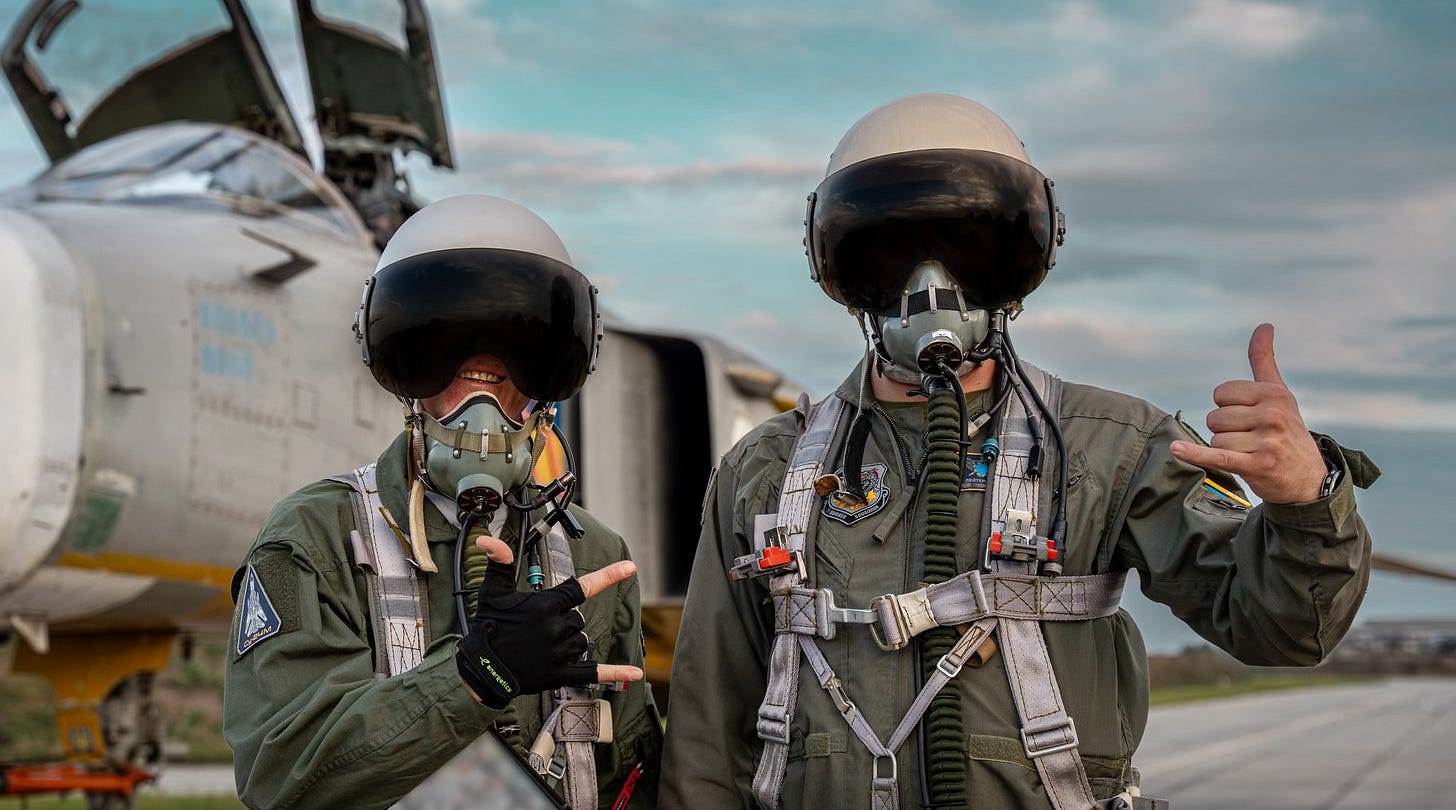
Welcome to the 9 February 2025 edition of The Big Five.
This week, as the Trump administration continues talking about how it might ‘end the war’ in Ukraine, I explore key events from the war in Ukraine and then examine how the strategic competition with China is playing out in the Pacific. As always, I will finish with my five recommended reads on war and national security from the past week.
In my weekly commentary The Week at War, just published here, I explore the role of adaptation in the Ukraine War so far, and what we can learn from this.
Ukraine
Peace Initiatives. The Ukrainian President may meet President Trump in Washington DC in the coming week, according to Trump. He mentioned the Zelenskyy visit during a press conference with the visiting Japanese prime minister. The U.S. president noted that "I will probably be meeting with President Zelensky next week, and I will probably be talking to President Putin. I'd like to see the war end.”
Apparently, a plan is in development by the U.S. administration to end the war. Although there was some speculation that it would be released by special envoy Keith Kellogg at the Munich Security Conference, these rumours have been quashed by Kellogg. As Kellogg noted during the week, "we are going to have great discussions with senior leaders in the European environment and bring back what we found out to the President of the United States and then go from there." Given the pending discussions between Trump and Zelenskyy as well as between Trump and Putin, it is hard to believe that they are ready to announce such a plan. It is likely that these disucssions will inform the plan - or at least we should hope so.
One of the key ‘sticks’ that the Americans hope to use against Russia is the threat of even harsher economic sanctions. As Kellogg described this week, the existing U.S. sanctions against Russia are a "3 on a 10-point scale". Kellogg believes that there is significant capacity to for even tougher sanctions.
So, in short, we probably should not expect any big American plan in the short term, at least until an initial round of discussions takes place, including Trump’s discussions with Ukrainian and Russian leaders, as well as Kellogg’s discussions during his forthcoming visits to Munich and Kyiv.
One complication might be that we don’t know whether Elon Musk will have a view on this and seek to influence Trump’s decisions. And, given the announcement by Trump about Gaza this week, the mercurial American leader could always surprise us with another poorly conceived and impossible to execute announcement about Ukraine. I think that is a low probability, but there are many things occuring right now that were probably seen as ‘low probability’ a few months ago!
The Ukrainian President this week confirmed that he has held discussion with the new U.S. President about Ukraine potentially sharing rare earth minerals with the United States. Trump said Monday that he wanted Ukraine to supply the U.S. with such minerals as payment for the support Washington has provided to Ukraine since February 2022. The German Chancellor, Olaf Scholz, has criticised this move by Trump however, describing it as “selfish and self-serving.”
In the past 24 hours, the Ukrainian president published a long thread on Twitter / X that explored the rationale for Russia’s invasion of his nation. He offers that access to Ukraine’s resources is a key reason for Russia’s continuation of the war, noting that “Putin does not need more land—Russia is already the largest country in the world. He knows that to destroy Ukraine, he must keep advancing. And in his path lies a land rich in natural resources—Ukraine.”
I recall that when I worked in the Afghanistan-Pakistan Coordination Cell in the Pentagon in 2010-2011, there was discussion about how Afghanistan’s mineral wealth (put at about US2 trillion by the U.S. Geological Survey in one briefing I attended) would underpin Afghanistan’s future. Now, I was brought up in a mining town, and I have a sense of the massive investment and logistics required just to extract minerals, let alone process them, find markets for them and get them to market.
Notwithstanding the clever politics of this initiative from the Ukrainians, we should not be holding our breath for this to bear fruit any time soon given these practical issues with developing rare earth deposits. And, of course, rare earths are not rare. What is rare is the number of countries that will permit the highly corrosive and polluting processing of these minerals. I note there was nothing about this in any of the annoucements about rare earths during the week.
War by Robots. Back in 2018, I published a report with CSBA that explored the application of remotely operated and autonomous systems in ground combat. Since the beginning of the war in Ukraine, this has been a fertile topic for many scholars and commentators. More recently, I examined the Battle of Lyptsi as well as other actions that have seen the application of the next generation of robotic systems by the Ukrainian military. I have also examined how we might translate the lessons of such actions for use in the Pacific theatre.
This week, an interesting article appeared at The Counteroffensive with Tim Mak which provided the most detailed exploration of the Battle of Lyptsi yet. It examined the planning and preparations for the integrated UGV-UAV battle, its rehearsals and preparations in the electromagnetic spectrum, as well as the conduct of the battle and initial lessons learned.
Also in news related to drones, Japanese news agency NHK has reported that Russia and North Korea are about to begin collaborating on the co-production of drones for the North Korean military. That Russia and North Korea will be sharing lessons about the war is hardly a surprise. However, this will undoubtedly drive a wave of learning about modern war, and restructuring, in the North Korean armed forces which will be problematic for the Ukrainians in Kursk, and for the South Korean and American military forces that must defend against any North Korean attack on the Korean penninsula.
Reorganising the Ukrainian Ground Forces. This week, General Syrskyi reaches the one year mark as the Commander-in-Chief of the Ukrainian Armed Forces. General Syrskyi noted in an interview this week that “the preservation of Ukrainian soldiers' lives remains our top priority. To achieve this, we have developed and implemented a comprehensive program focused on modernising the army, improving soldier training, and enhancing medical care at all stages.”
One of the measures to modernise the army, the formation of new army corps, was announced by the Ukrainian president this week. This will see the restructuring of ground forces and the national guard to include more corps-level organisations.
Good stories on this topic were published during the week by MilitaryLand and by Stefan Korshak at the Kyiv Post. I recommend both of them, although there is still much we don’t know about this initiative.
I wrote a separate piece on the opportunities and challenges of Ukraine forming more corps (it already has several) earlier this week, and you can read it at this link. One of the key challenges will be appropriate numbers of commanders and staff with the right balance of experience and training. As Stefan Korshak notes in this recent piece, the Ukrainians have already discovered that there is no short cut to achieving this.
The Ground War. The key news on the ground this week was the Ukrainians undertaking an advance out of their Kursk defensive position, creating a 5 kilometre deep salient south east of Sudzha. This does not constitute any new offensive campaign, and may create more of a liability than an asset for the Ukrainian defenders. At the six month mark of this incursion into Russia, the Ukrainians are holding their ground, but the size of the salient is only about 40% the size of the original salient created in August 2024.
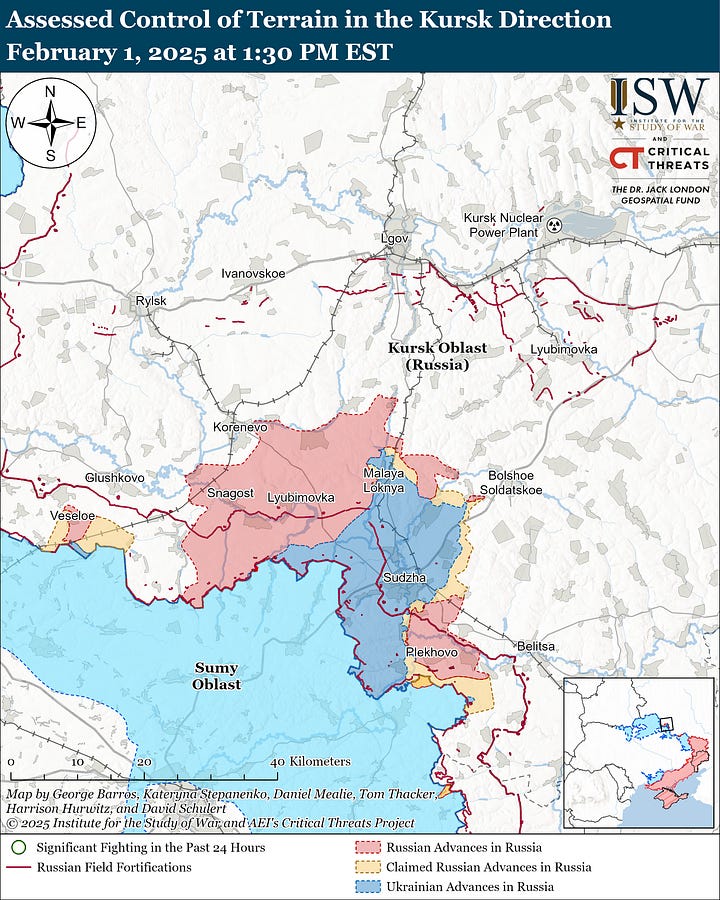
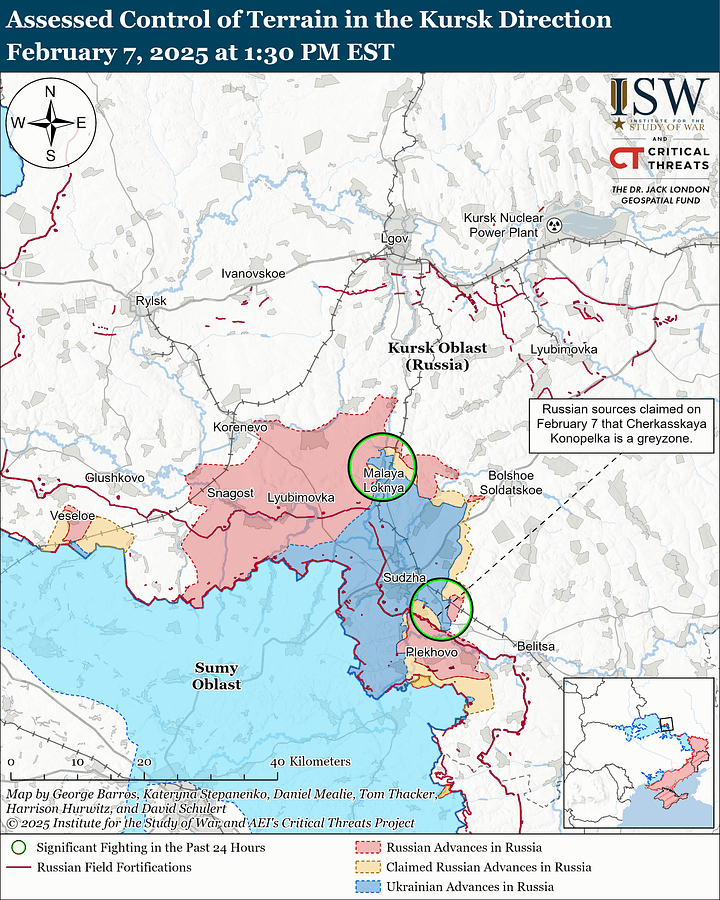
Also in Kursk, the North Koreans have apparently returned to frontline operations. Reports this week suggest that, after a three week absence from battlefield activities, the North Koreans have returned. They were part of a Russian-North Korean series of dismounted attacks against the Ukrainian 47th Brigade this week, which saw multiple, concurrent attacks by the Russians distributed across the front line. Apparently casualties on the Russian-North Korean side were heavy as shown in recently released videos of the engagements.
In other parts of the frontline, the Russians have continued to achieve small advances on multiple axes of advance. This includes the following areas: Siversk, Kramatorsk, Chasiv Yar, Toretsk, Pokrovsk, Andriivka, Huliaypole and northwest of Robotyne. But as the most recent update on Ukrainian territory seized Russia compiled by @War_mapper shows, the Russian advances and seizures of Ukrainian territory in eastern and southern Ukraine have slowed over the past two months. This does not mean they are culminating, but does demonstrate that Russian forces are starting to feel the pinch after the high casualties of the past six months.
In other news about the ground war, the Ukrainians this week apparently shot down a Russian glide bomb near the city of Zaporizhzhia. The downing was reported by Air Force spokesperson Yurii Ihnat on 7 February, who noted that, "to counter this threat, we need a comprehensive approach — both the use of ground-based air defense and aviation components to drive the carriers of these KABs as far as possible." No further details were provided on how this interception was achieved, although there are reports that experimental weaponry was used.
These Russian glide bombs, or guided aerial bombs (KABs), have been a consistent challenge for the Ukrainians in the past 18 months. This recent report by RAND is a good exploration of the problem. They are cheap to produce, and the Russian airforce aircraft that carry them are able to launch the bombs in large numbers against Ukrainian ground positions from inside Russian territory or Russian-occupied territories. This puts them outside the range of Ukrainian air defence systems.
One of the methods the Ukrainians have turned to is attacking munitions depots that store the glide bombs (such as those conducted in December last year) in order to deny them to the Russian air force.
These glide bombs, which are very difficult to intercept after launch because of their significant weight and high speed, have caused significant damage to tactical ground defences and civilian targets. The Russians employ several different glide bombs, including 250, 500, 1,000 and 1,500 kilogram high explosive (HE) variants, and more recently, a 3,000-kilogram HE bomb.
The amount of damage these weapons cause is extraordinary and orders of magnitude beyond the damage caused by individual artillery rounds. The Russians use them in large quantities (thousands per month). Any potential solution to these weapons for the Ukrainians would help reduce the number of casualties Ukraine is suffering on the ground, and degrade the Russian’s ability to continue its advance on the eastern front. Glide bombs are one of the key Russian asymmetries that they have at the moment (the other is manpower), and if this can be negated it would be a significant achievement for the Ukrainians.
Finally, just when we thought the situation with recruiting in Ukraine could not get more dire, this week it was reported that a series of bombings had occured in Ukrainian military recruitment centres. In the last week, there were explosions at three draft separate recruiting centres across Ukraine. Those carrying the bombs were killed in at least two of these incidents and many others were injured. Ukraine’s domestic security service has accused Russian intelligence agencies of planning the attacks as well as recruiting people to carry them out.
The Pacific
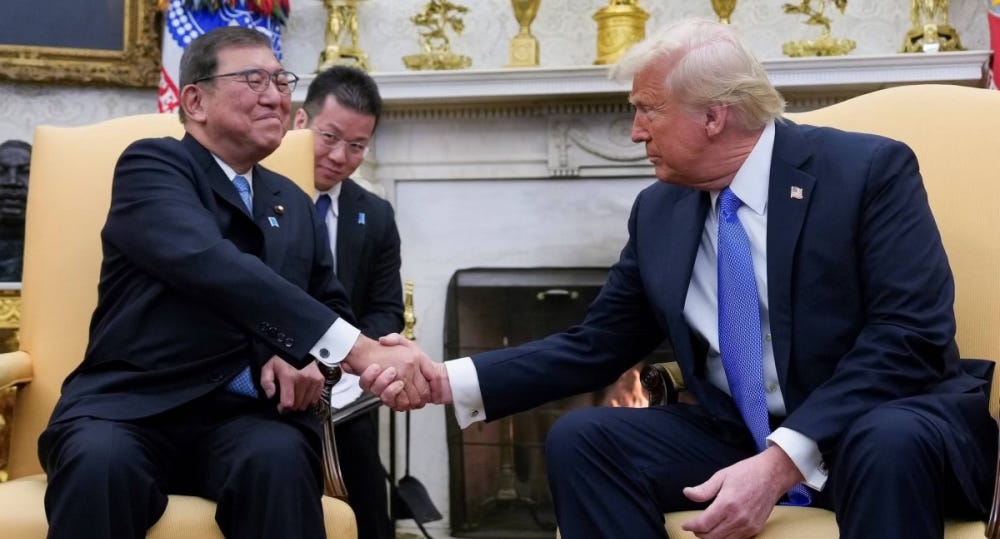
This week, the Japanese prime minister met with President Trump in Washington DC. The leaders confirmed the close defence relationship, with the joint statement issued after the meeting noting that “the United States underscored its unwavering commitment to the defense of Japan, using its full range of capabilities, including nuclear capabilities.” A range of other issues were discussed including cooperation on technology and military infrastructure.
Two other issues were discussed and included in the joint statement. First, security and stability in the Indo-Pacific:
The two leaders shared views on the severe and complex security environment and expressed their determination to continuously cooperate to realize a free and open Indo-Pacific. As part of such cooperation, the two leaders intend to advance multilayered and aligned cooperation among like-minded countries, including Japan-Australia-India-U.S. (Quad), Japan-U.S.-Republic of Korea (ROK), Japan-U.S.-Australia, and Japan-U.S.-Philippines.
The other topic was the threat posed by China and stability across the Taiwan Strait:
The two leaders reiterated their strong opposition to any attempts by the People’s Republic of China (PRC) to change the status quo by force or coercion in the East China Sea. The two leaders reaffirmed their strong opposition to the PRC’s unlawful maritime claims, militarization of reclaimed features, and threatening and provocative activities in the South China Sea. The two leaders emphasized the importance of maintaining peace and stability across the Taiwan Strait as an indispensable element of security and prosperity for the international community.
How this actually plays out on the ground, given Trump’s statements about tariffs on allies and the need for countries like Taiwan to increase their defence spending remains to be seen.
In news related to Taiwan, this week Ray Powell published an investigation into suspicious behaviour by Chinese commercial vessels in the vicinity of Taiwan. You can read that at this link. The Taiwanese authorities have also listed 52 vessels as ‘suspicious’, which you can read about here.
The Chinese also continue to step up the level of ‘normal’ maritime and air aggression around Taiwan. The latest update on this issue from Damien Symon is posted above.
This week, the Asian Military Review published a useful report on the increased spending by the Japanese Self Defence Force that was announced last December. Japan announced then a record amount of $55.9 billion (JPY7.95 trillion), a 16.5 percent increase from the previous year. The Asian Military Review update covers the ongoing expansion and development of all three of Japan’s military services, as well as developments in their defence industrial base. You can read the full story at this link.
Finally, it would be remiss of me to not mention the fantastic work of the Sappers from the 3rd Combat Engineer Regiment of the 3rd Brigade, Australian Army, who this week reopened a critical highway route in north eastern Australia. In the middle of awful weather conditions, they constructed a Medium Girder Bridge (MGB) to replace the span of bridge taken out by recent flooding in the area. They demonstrated the utility and ingenuity for which Sappers are renowned. Well done!
*****
This week I published two pieces here. First, I examined the announcement this week about the Ukrainian ground forces restructuring initiative that would see more Army Corps formed. The article examined the opportunities and challenges of the initiative, and was mentioned on this Ukraine: The Latest podcast. Later in the week, I spoke with the folks at the Command and Control podcast on this topic (you should see that released shortly). You can read the article here.
I also published a piece this week on the agreement by 38 nations to establish the Special Tribunal for the Crime of Aggression against Ukraine. Because the existing International Criminal Court is unable to exercise jurisdiction over the crime of aggression unless both the victim and the aggressor state have ratified and accepted the Court’s jurisdiction over that crime, which would be subject to a Russian veto, a separate tribunal is required. You can read the article here.
I also had discussions on two separate podcasts that were released this week. The first was a fun and interesting discussion with my friend, Aaron MacLean from the Hudson Institute on his School of War podcast. We had a wide ranging discussion about the application of fiction in thinking about future military challenges, and our shared love of Tom Clancy’s novel, The Hunt for Red October. You can listen to our discussion here.
The second podcast was released by the Australian National Security College. Along with my friend Misha Zelensky, we had a conversation about fiction, how it might be used to tell stories about the war in Ukraine, and its application in national security more broadly. You can listen to that episode of the National Security podcast at this link.
*****
So, to my recommended readings…
This week, there is a interesting piece on China’s strategy for dealing with the new Trump administration, and how it intends to leverage mistakes by the administration to improve its standing and power in different parts of the world. I have also included articles that examine the reconstitution of Russian military forces in the wake of the Ukraine War as well as about rethinking America’s policy with regards to tactical nuclear weapons.
Finally, there are interesting articles on the future of military training and an a long update on the Russian rationale for continuing its war from the perspective of the Ukrainian president.
As always, if you only have time to read one article, the first one is my pick of the week.
Happy reading!
1. China’s Strategy for the Trump Presidency
Foreign Affairs this week published an interesting article on how China is thinking about, and implementing, its strategy for the new Trump administration. As the author notes, “they think that Trump’s policies will undermine U.S. power and reduce U.S. global standing in the long run. And when that happens, China wants to be ready to take advantage.” You can read the article at this link.
2. Zelenskyy’s Update on the Status of the War
In the past 24 hours, the Ukrainian president published a long thread on Twitter / X that explored the rationale for Russia’s invasion of his nation. He offers that access to Ukraine’s resources is a key reason for Russia’s continuation of the war, noting that “Putin does not need more land—Russia is already the largest country in the world. He knows that to destroy Ukraine, he must keep advancing. And in his path lies a land rich in natural resources—Ukraine.” You can read the full thread here.
3. Future Military Training
It is no secret that I have a passion for the examination of military eduction and training, and it is something I have written about (and led as a senior Army officer) in the past couple of decades. In this article from War on the Rocks, the author examines improved methods for the transfer of knowledge in military training systems. You can read the article here.
4. Rethinking Tactical Nuclear Weapons
Tactical nuclear weapons are different from strategic weapons primarily because of their intended effect and the way in which they are delivered. They are designed to disrupt an enemy achieving its objectives, cause casualties, overwhelm medical units, create logistical shortfalls and panic civilian populations. Given the nuclear sabre rattling by Putin, and the continued growth of China’s nuclear arsenal, this article proposes that the U.S. needs to rethink its policies for tactical nuclear weapons. You can read it here.
5. Rebuilding Russia’s Military
The reconstitution of Russian forces, particularly their ground forces, has been an area of study that was reinvigorated in the wake of Russia’s initial failures in 2022 and has been driven by their continued high battlefield losses. In this new RAND publication, the authors examine not only the reconstitution of military forces but also the role of defence industry. Not only of relevance to the war in Ukraine, this work will be of interest to other eastern European nations that are carefully watching Russia’s imperial aspirations. You can read the report here.




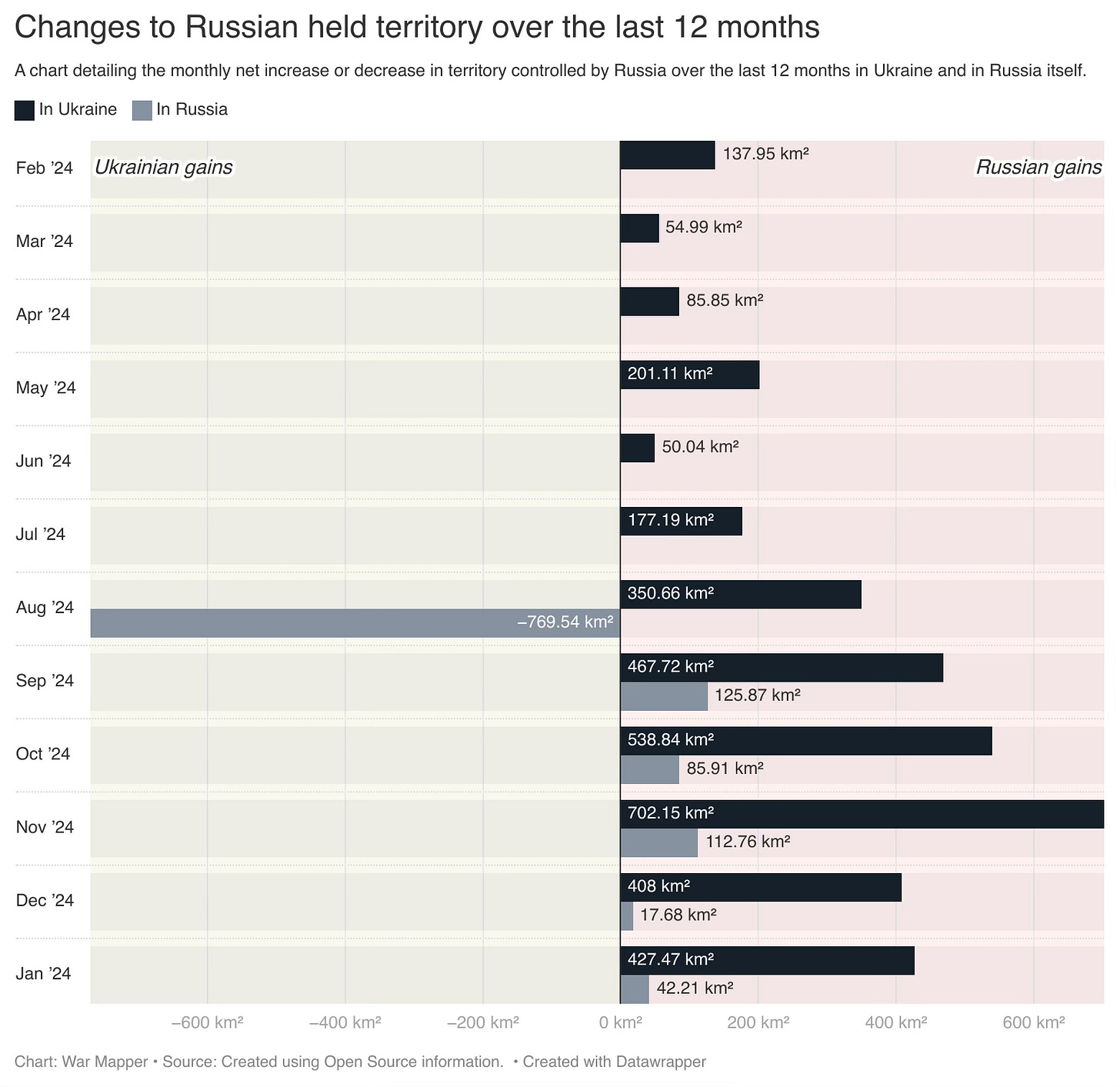
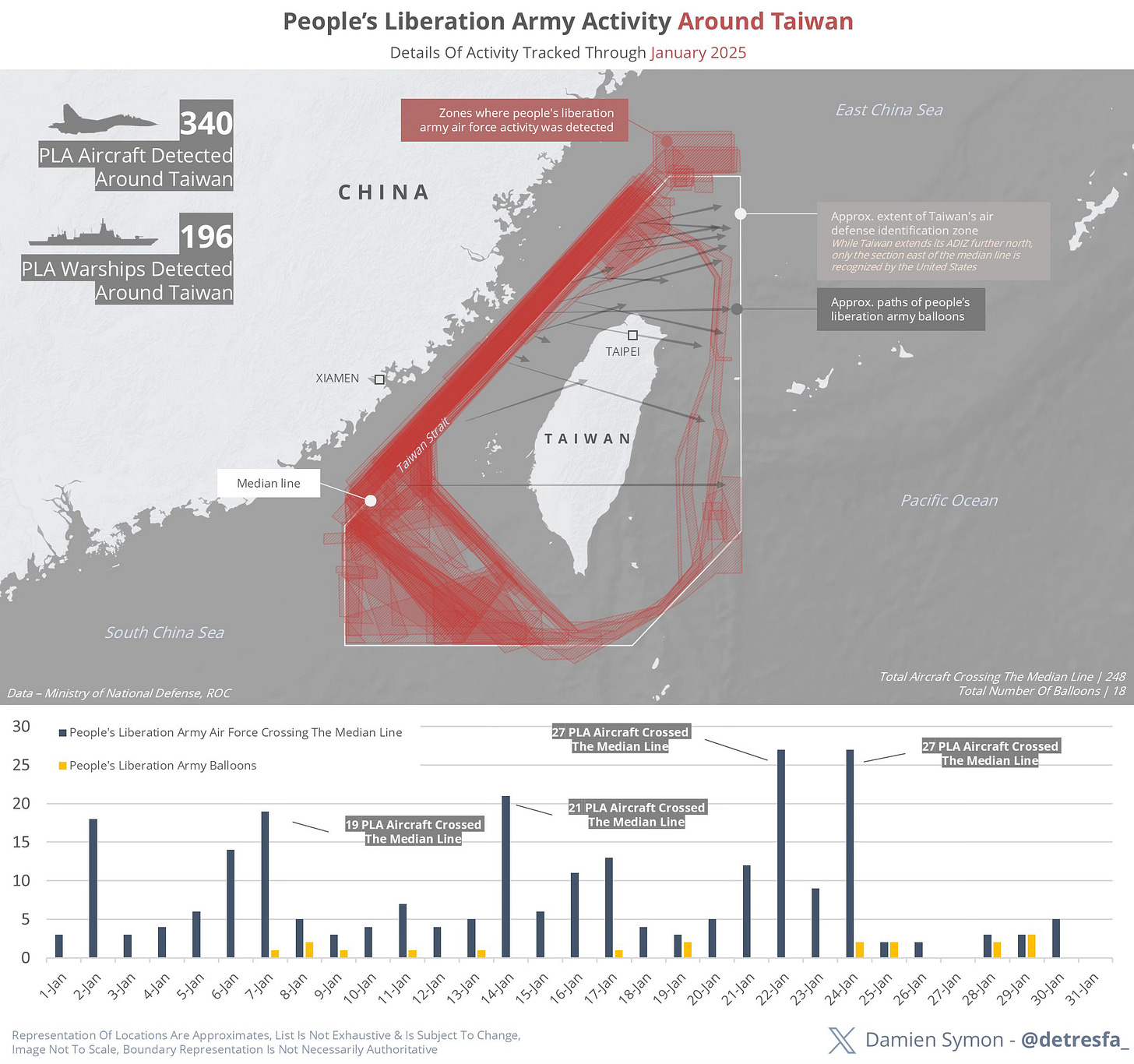
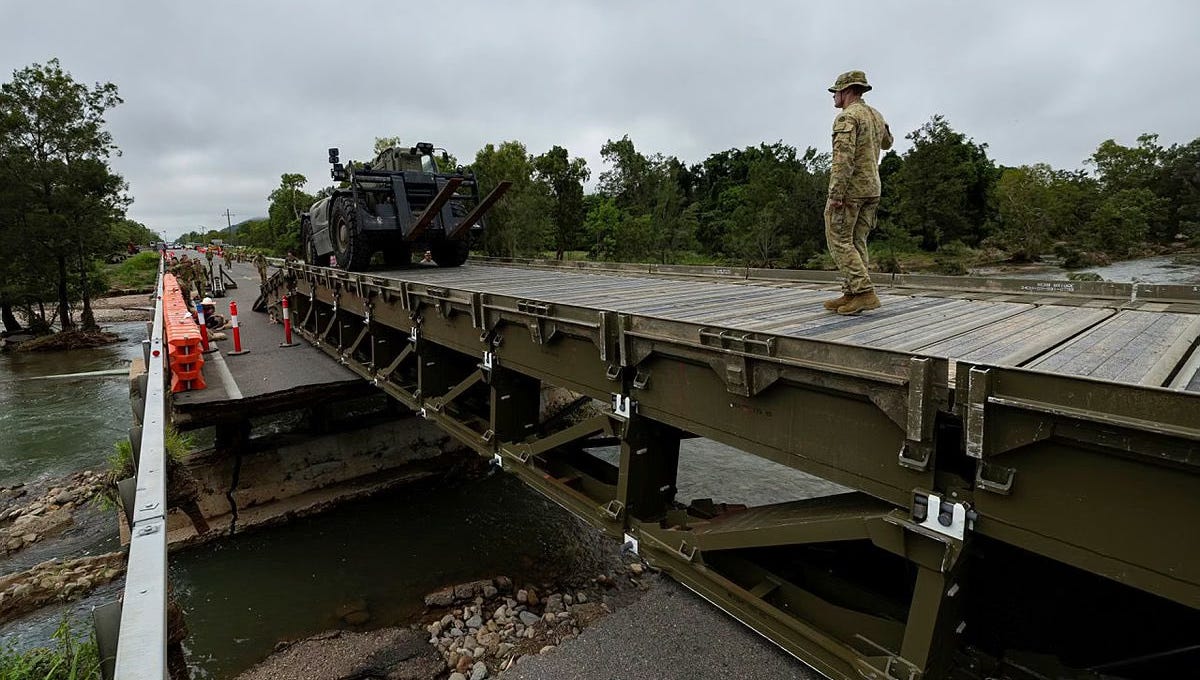

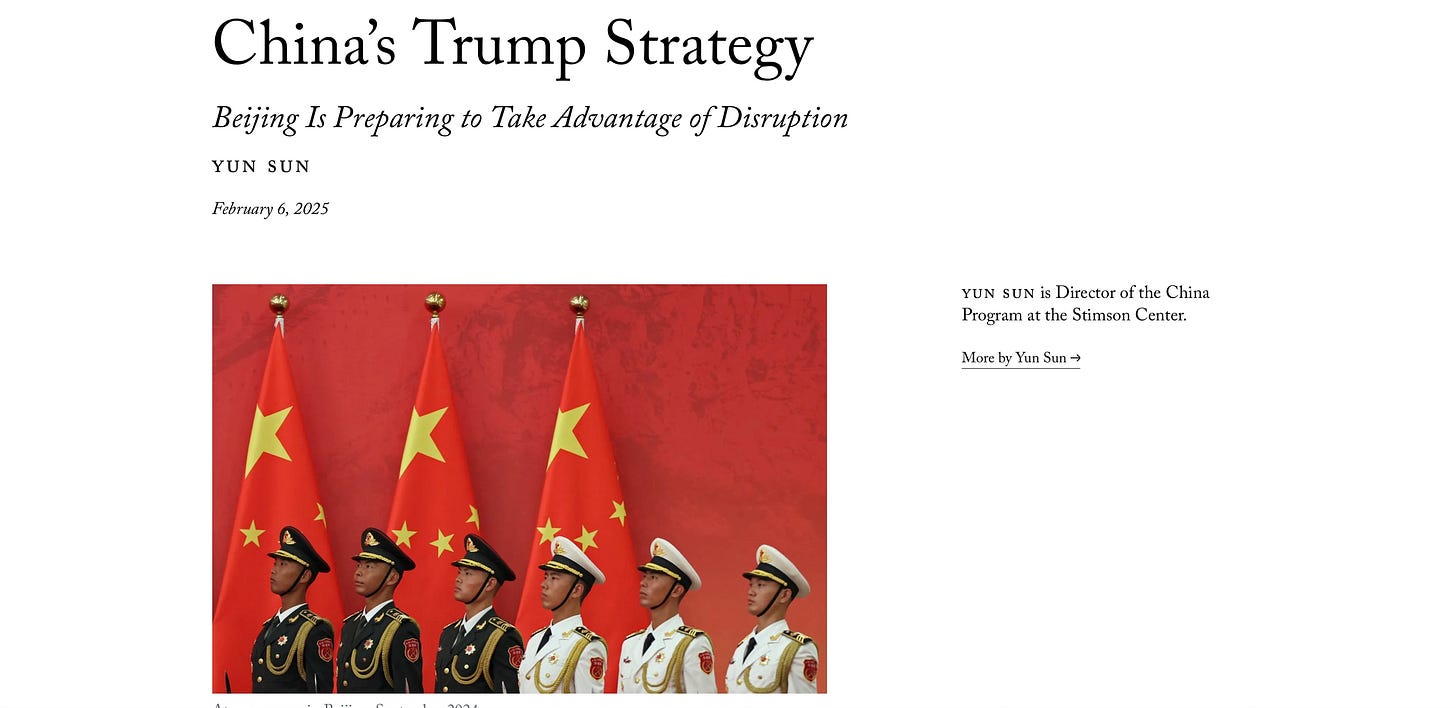
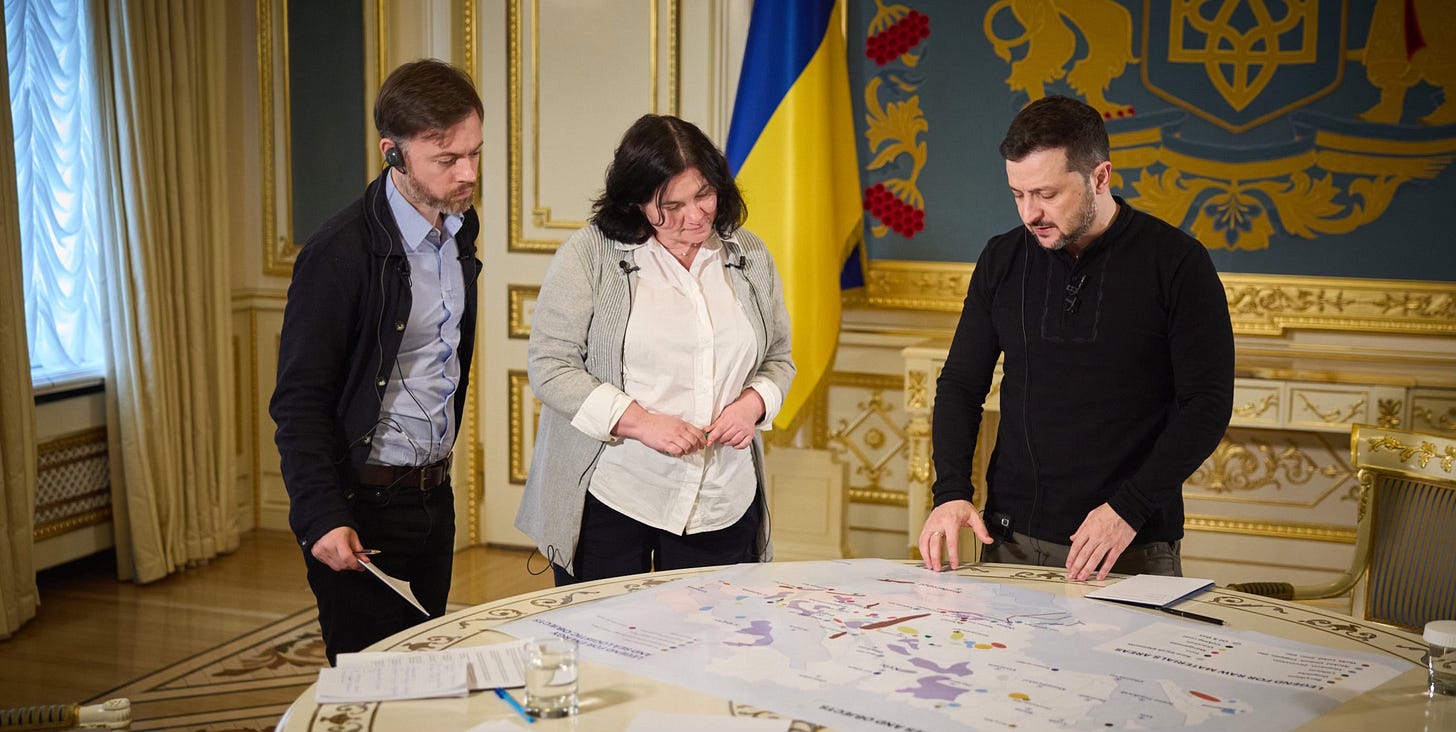

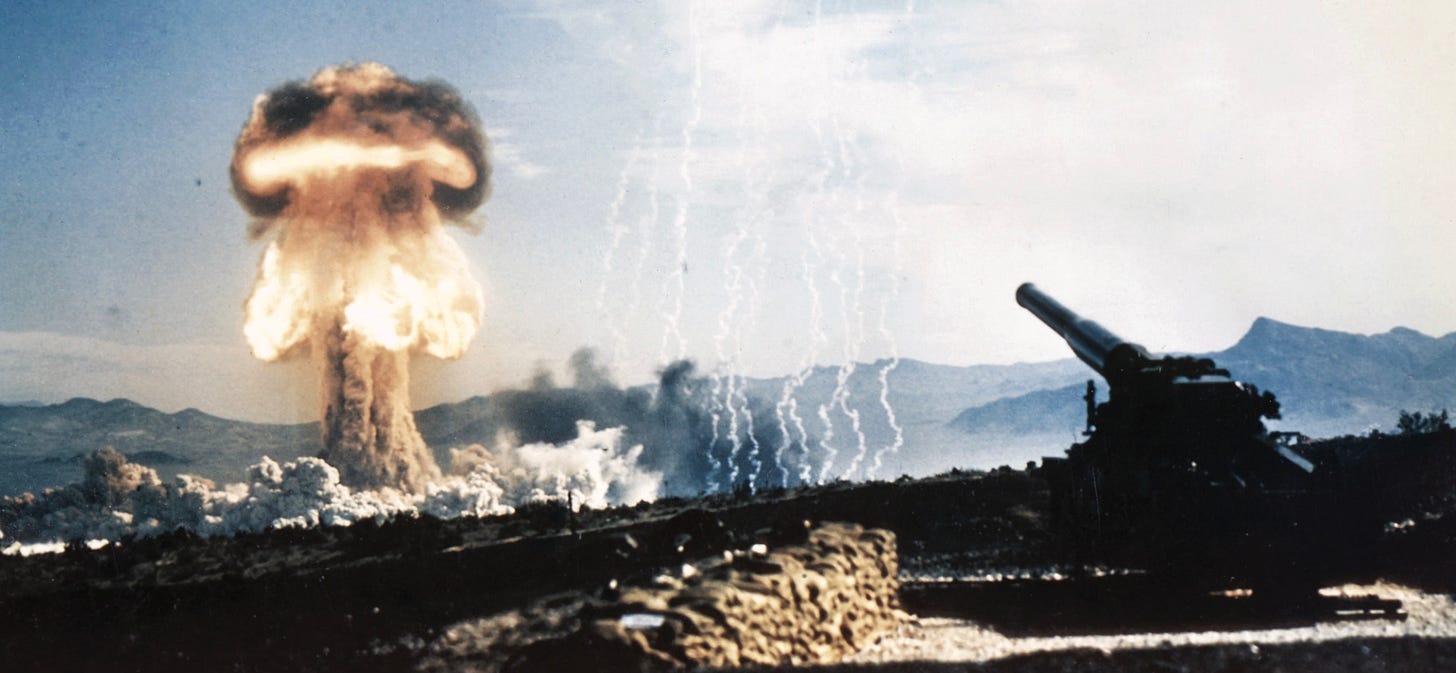
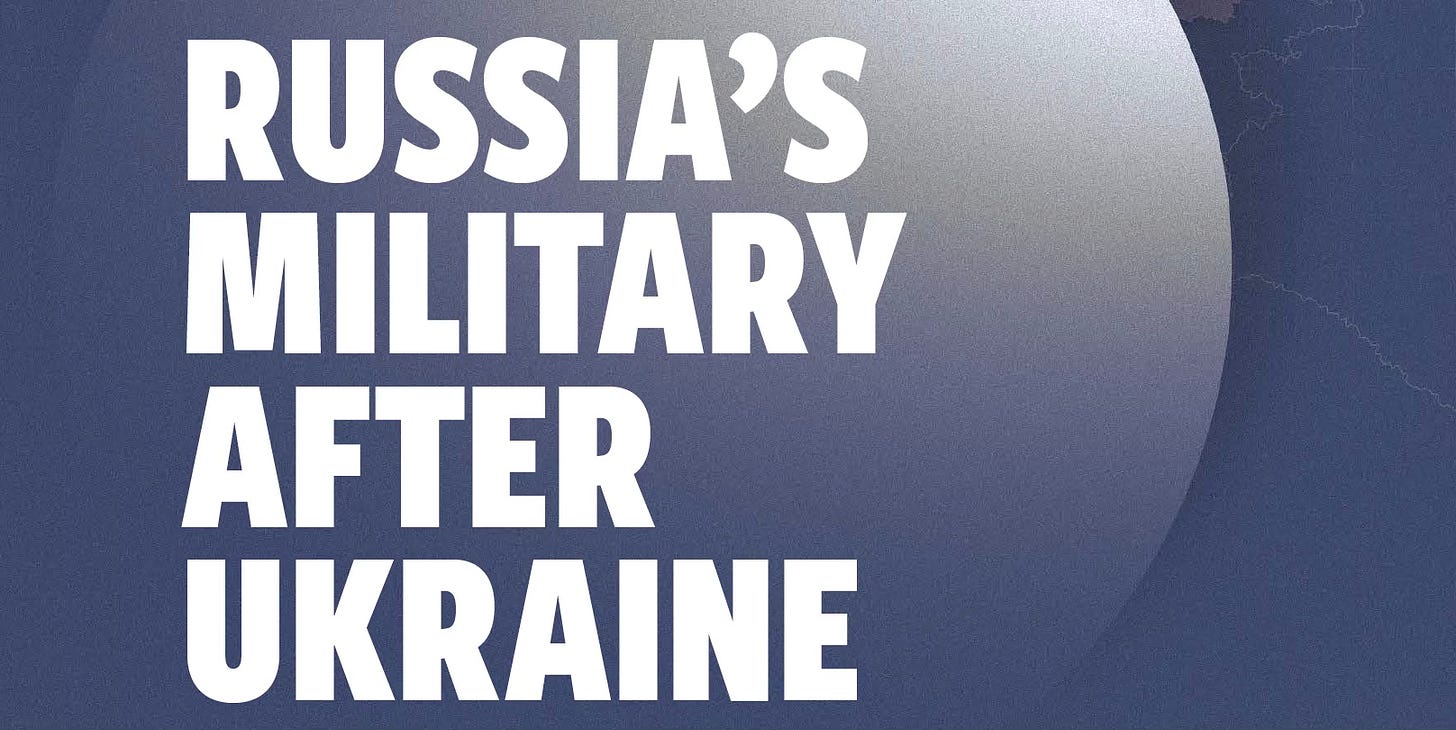
Thanks a lot for these summaries. While I don't have the time to read the articles you link, the broad summary is an excellent way to keep up.
Question: why are glide bombs an asymmetry towards Russia? Can't Ukraine deploy the same?